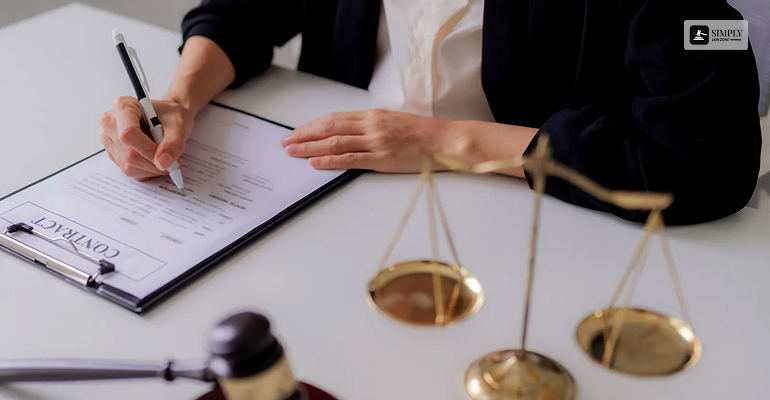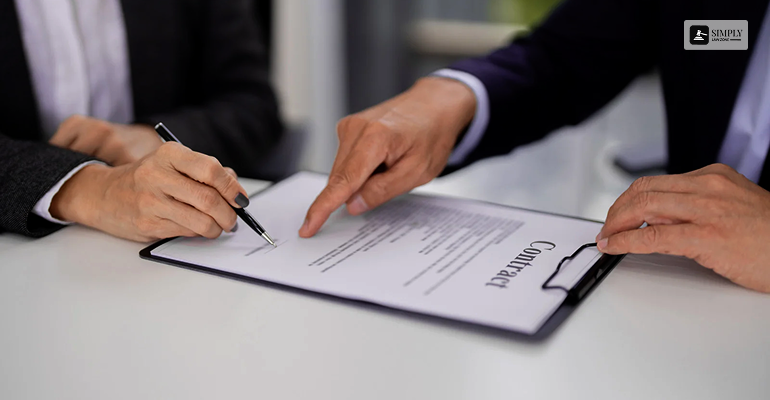
Contracts are the basis of all business and personal agreements. Individuals spend so much time and energy writing down their contracts. So, their desire is that the last written contract should be enforced by the courts. That is where parol evidence rule comes into play.
Heard of parol evidence rule contract law? Yes, this rule is one of the cornerstones of contract interpretation and a fundamental principle of contract law. You must understand this rule to protect yourself in any contract.
Heard of parol evidence rule contract law? Yes, this rule is one of the cornerstones of contract interpretation and a fundamental principle of contract law. You must understand this rule to protect yourself in any contract.
What Is The Parol Evidence Rule?
What is the parol evidence rule is a rule of law? This rule forbids parties from introducing “extrinsic evidence” to contradict or alter the terms of a contract.
This applies even when the contract is completely written and “integrated”. Think of “extrinsic evidence” as information beyond the four corners of the paper.
Thus, this includes the following.
- anything in the form of prior agreements (oral or written)
- contemporaneous oral agreements.
- The word “parol” actually comes from the French word for “word” or “speech.”
According to the Legal Information Institute, the Parol rule of evidence preserves the sanctity of the written contract. Additionally, this rule discourages parties from fabricating evidence of a completed agreement.
The reason is self-evident: if parties take the trouble and time to commit their agreement on paper, then the paper must be accepted as the conclusive and complete record. This rule brings certainty and predictability in the law of contracts.
What Are The Core Principles Of The Parol Evidence Rule?

The use of the parol evidence rule hinges on one underlying concept of integration. A contract is “integrated” if the parties intended the written instrument to be the complete and final expression of their understanding.
Courts determine if a contract is one of full integration or partial integration.
1. Totally Integrated
This is the most restrictive level. The rule of parol evidence excludes all extrinsic evidence that will conflict with or even add to the written contract.
2. Partially Integrated
The written agreement is conclusive for its terms, but not an exhaustive report of the entire transaction.
- Here, parol evidence still bars evidence contrary to the written terms. Even so, courts receive consistent, outside terms to complete the writing.
- You typically have a “merger clause” or “integration clause” in a commercial written contract.
- The clause states directly that the document is the entire and final agreement. This language directly expresses the parties’ desire for complete integration.
- Therefore, having a strong merger clause strengthens the application of the parol evidence rule.
- If ever parties dispute a term of an entirely integrated written agreement, the parol evidence rule prevents them from saying, “But we orally agreed to something else before we signed!”
This is proof of the power of the parol evidence rule.
What Are The Exceptions To The Rule Of Parol Evidence?

This rule is not strict. There are numerous parol evidence rule exceptions. They allow extrinsic evidence in some cases. Courts use these exceptions to prevent injustice and ensure fairness.
Following are the most common rule exceptions:
1. Clarifying Ambiguity
If a contract term in the written agreement is reasonably capable of more than one meaning, the court will admit parol evidence. This will allow the judge to establish the original intent of the parties.
2. Proving Invalidity (Fraud, Duress, Mistake)
There is always going to be an admission of extrinsic evidence to prove that the contract is void or voidable. This includes proof of fraud, duress, undue influence, mutual mistake, or lack of consideration.
For instance, Reuters Practical Law states that a party can prove they were tricked into signing an agreement against the written conditions when the terms in writing contradict the claim.
3. Establishing A Condition Precedent
Evidence is permissible to prove that the parties had an oral agreement of a condition preceding the effective date of the written contract.
4. Proving A Collateral Agreement
Parties may introduce evidence of an independent, collateral agreement.
However, the collateral contract should not be contrary to the main writing and must be an agreement that parties are not usually expected to put into the main writing.
5. Clerical Or Typographical Errors
You can use extrinsic evidence to correct a simple error, e.g., a misplaced digit or misspelling, to put forth the true consensus of parties.
Jurisdictional Variances In Application Of The Rule
The parol evidence rule originated in the concepts of common law. Its application might vary in various jurisdictions.
Corbin Rule
The majority of states in the United States follow a liberal policy. They allow the court to consider extrinsic evidence to determine if the contract is ambiguous before considering the evidence.
This is what we call the “Corbin” rule.
A few US states, like Colorado and Florida, have a rigid “Four Corners Rule”. In those states, a court considers only the document itself. Moreover, the court can accept parol evidence only if the wording is absolutely ambiguous on the face of it. The parol evidence rule applies very strictly in this situation.
Four Corners Rule
Courts within the United Kingdom traditionally took a strict approach. They stress highly the finality of written words. However, the rule softened over time. UK courts, for example, would take the surrounding facts into consideration to determine the meaning of vague words.
Practical Uses Of Contract Drafting And Litigation

The parol evidence rule is something that contract drafters can learn from that is extremely potent. If you are serious about your agreement, you must put it in writing in a clear and comprehensive manner.
Use A Merger Clause
Always utilize a strong merger clause. This lets your intent be known for the document to be a complete integration. The parol evidence rule best protects a completely integrated written contract.
Be Specific
Don’t leave anything open to interpretation. Define every term, price, date, and duty precisely. Ambiguity is the easiest way to sidestep the rule.
Put Everything In Writing
If an oral promise or collateral agreement is important, be sure to include it in the final written agreement. Moreover, you can create a stand-alone, enforceable addendum. Otherwise, the parol evidence rule may prevent you from subsequently enforcing that oral promise.
Case Studies Illustrating The Application Of The Rule
In litigation, the parol rule is a tool that is at the disposal of a defendant. Thus, the defendant can use it to prevent the opposing party from producing useful negotiations prior to the contract.
1. Riverisland Cold Storage v. Fresno-Madera Production Credit Ass’n
One recent event involving the rule of parol evidence was observed in California.
In the Riverisland Cold Storage v. Fresno-Madera Production Credit Ass’n case, the California Supreme Court adopted a broader approach to the fraud exception. The Court allowed borrowers to introduce proof of a lender’s contradictory oral promises.
Moreover, these oral promises were made to falsely induce the execution of a loan agreement.
So, this landmark ruling made it easier for parties to use parol evidence to prove fraud. Additionally, this will work even if the evidence was contradictory to the written terms. It shows judicial willingness to soften the rule for justice.
2. Williams v. Spitzer Autoworld Canton, LLC
The Ohio Supreme Court handled Williams v. Spitzer Autoworld Canton, LLC. Here, the court applied the rule to disqualify a consumer’s suit. The suit alleged that a car dealer orally promised a higher trade-in value than the previous agreement depicted.
Therefore, this decision reaffirmed that a consumer cannot enforce oral pre-contract statements contrary to the final signed agreements.
Read Also: What Is A Unilateral Contract And When Do You Need It?
Professional Advice For Navigating The Parol Evidence Rule
Understanding the rule is at the heart of interpreting contracts. Attorneys must treat contract issues carefully.
1. Make Everything A Record
Ask clients to make a record of all significant communications. Although the parol evidence rule might make them inadmissible, they are crucial when attempting to establish a case on an exception to the rule.
2. Review For Integration
Always review a contract to determine its level of integration. A court will enforce a partially integrated contract where the contract does not contain certain fundamental terms.
Moreover, if you are the enforcer wanting to enforce the written contract, ensure that it is completely integrated.
Emphasis On Post-Contract Changes
Remember that the rule of parol evidence applies only to contracts that have been made before or at the same time as the written agreement.
- However, it does not rule out evidence of a later written alteration of an agreement.
- The rule of parol evidence is a safeguard against written agreements. It forces people to take their written promises seriously.
- Thus, the rule remains a fundamental principle of contract law. It raises a strong presumption that the written document states the parties’ final agreement.
- Moreover, the rule is not just some sort of magic trick with courtroom novelty to suppress a witness’s testimony.
- Instead, it is a foundational principle that will help judges in preserving the true meaning and completeness of the written agreement.
- While exceptions to the rule offer some margin for flexibility, the first lesson is clear: make your contracts specific.
Therefore, your written contract should include all of the terms. What you sign in any contract is what you get. The parol evidence rule protects the integrity of your written contract.
Frequently Asked Questions (FAQs):
People find themselves in all kinds of trouble because they accept word-of-mouth agreements on face value without checking the final document. The rule specifically addresses such situations. Following are some questions regarding the rule.
Yes, the rule still applies even if a contract is partially integrated. A partially integrated contract is sufficient regarding the terms it contains.
The rule does not admit any evidence contradicting the specific written terms. However, courts may allow evidence of other terms that are not present in writing.
The UCC, which governs sales of goods, generally adheres to the basics of the parol evidence rule. Although, some may call it more liberal.
Uniform Commercial Code (UCC) Section 2-202 allows parties to look at extrinsic data in order to interpret or fill in the final terms. Specifically, a court may look at:
• Course of Dealing: The manner in which the parties had been conducting themselves in their previous dealing with one another.
• Usage of Trade: The customs and usages in that specific industry.
• Course of Performance: How the parties have been performing the current contract so far.
This outside evidence is admissible even though the main contract language is seemingly unblemished. Thus, this is a departure from ancient common law rule of enforcing the written word strictly.
No. The rule that excludes evidence from outside altering a signed contract is only applicable to the agreements made before or after signing the final document.
It works only for future changes or modifications.
The parties may always amend their agreement after it has been finalized. Therefore, evidence showing that they entered into a later amendment is always receivable in court. Thus, it is not excluded under the rule against final written agreements.


